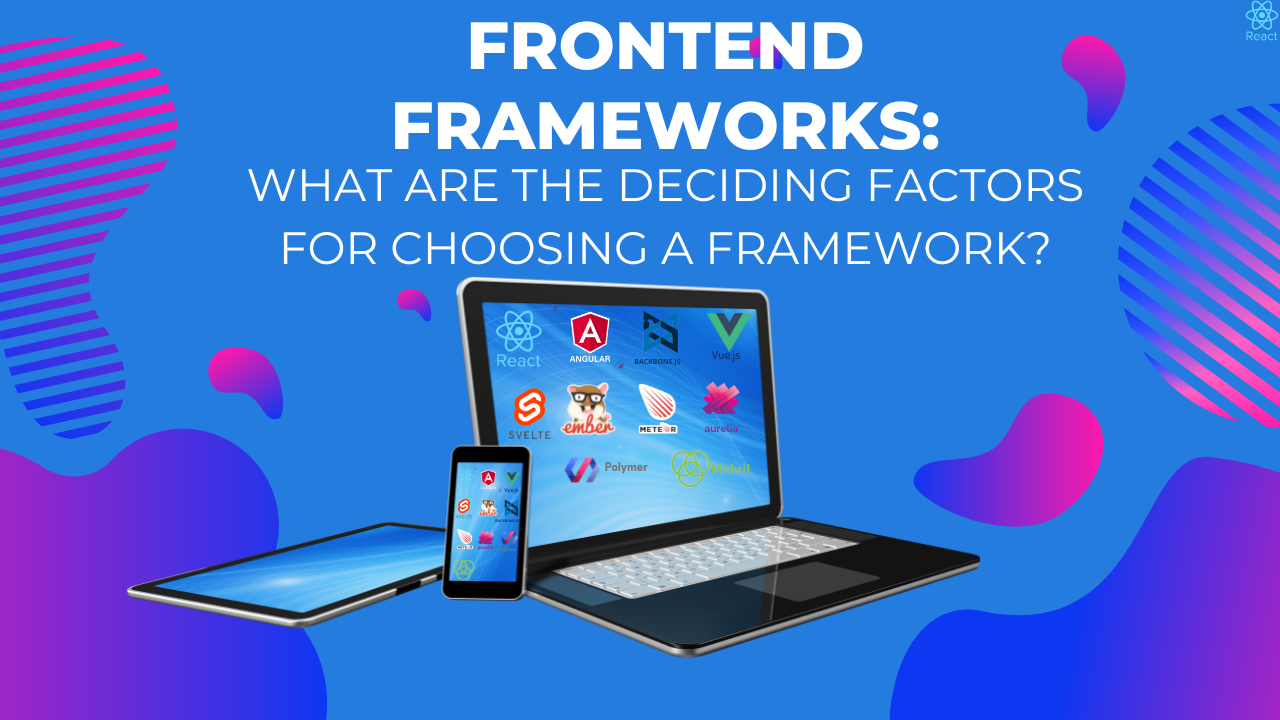When choosing a framework for your web application project several criteria should be considered to ensure that you select the most suitable framework for your specific needs. Here are some key criteria to consider:
Project Requirements: Understand the specific requirement of your project including the complexity of your user interface, the need for data handling and any performance considerations. Different frameworks have different strengths and weaknesses, so choose the one that aligns well with your project requirements.
Performance: Evaluate the performance of the framework, including factors such as rendering speed, memory usage, and browser compatibility. Choose a framework that is optimized for performance and can deliver a smooth and responsive user experience, especially on mobile devices.
Community Support and Documentation: Choose a framework that have strong community support and extensive documentation. A large and active community can provide valuable resources, such as tutorials, forums, and third-party plugins, which can help you overcome challenges and find solutions to your project.
Customisation and Flexibility: Assess the level of customization and flexibility offered by the framework. Choose a framework that allows you to easily customize the appearance and behaviour of your application, without imposing too many constraints or limitations.
Scalability: Consider the scalability of the framework and how well it can accommodate the growth of your project over time. Look for features such as modular architecture, code splitting, and support for server-side rendering, which can help improve the scalability of your application.
Compatibility with Existing Technology Stack: Consider the compatibility of the framework with your existing technology stack, including backend frameworks, databases, and other tools. Choose a frontend framework that integrates smoothly with your existing infrastructure to minimize compatibility issues and streamline development.
Community Trends and Adoption: Take into account the current trends and adoption rates within the web development community. Popular frameworks are often well-maintained, well-documented, and supported by a large ecosystem of developers and third-party libraries.
Learning Curve: Consider the learning curve associated with the framework. Some frameworks may have a steeper learning curve than other frameworks. Choose a framework that you can learn quickly and efficiently or that you already have experience with.
By carefully considering these criteria and evaluating your options based on your specific project requirements, you can choose a frontend frameworks that best suits the need of your projects and successfully builds your web application.





I don’t think the title of your article matches the content lol. Just kidding, mainly because I had some doubts after reading the article. https://accounts.binance.com/vi/register-person?ref=WTOZ531Y
Thank you for your sharing. I am worried that I lack creative ideas. It is your article that makes me full of hope. Thank you. But, I have a question, can you help me?
Can you be more specific about the content of your article? After reading it, I still have some doubts. Hope you can help me.
Your point of view caught my eye and was very interesting. Thanks. I have a question for you. https://accounts.binance.com/sk/register-person?ref=OMM3XK51
Your point of view caught my eye and was very interesting. Thanks. I have a question for you.
Thank you for your sharing. I am worried that I lack creative ideas. It is your article that makes me full of hope. Thank you. But, I have a question, can you help me?
Can you be more specific about the content of your article? After reading it, I still have some doubts. Hope you can help me.
Thank you for your sharing. I am worried that I lack creative ideas. It is your article that makes me full of hope. Thank you. But, I have a question, can you help me?
buy cheap clomiphene price cost of cheap clomid prices where to get clomiphene without dr prescription clomiphene sleep apnea how to buy clomid pill how to buy cheap clomiphene without prescription cost of generic clomid without insurance
Greetings! Utter gainful recommendation within this article! It’s the little changes which choice espy the largest changes. Thanks a a quantity towards sharing!
The thoroughness in this piece is noteworthy.
buy azithromycin 250mg for sale – floxin 200mg generic metronidazole uk
Thanks for sharing. I read many of your blog posts, cool, your blog is very good.
rybelsus over the counter – buy cyproheptadine 4mg pill buy generic cyproheptadine online
purchase domperidone pills – domperidone us cyclobenzaprine 15mg us
order inderal 20mg sale – inderal order buy methotrexate 10mg generic
amoxicillin online buy – order combivent without prescription order combivent 100mcg without prescription
order zithromax 500mg pill – order tindamax 500mg without prescription bystolic 5mg tablet
buy augmentin 375mg online cheap – https://atbioinfo.com/ ampicillin canada
cheap esomeprazole 20mg – nexium to us buy nexium 20mg pill
I don’t think the title of your article matches the content lol. Just kidding, mainly because I had some doubts after reading the article.
order warfarin pills – https://coumamide.com/ cozaar 25mg oral
meloxicam 7.5mg oral – tenderness mobic sale
purchase deltasone – adrenal deltasone 40mg pill
buy ed pills – site buy ed meds
cheap amoxicillin for sale – https://combamoxi.com/ amoxicillin uk
brand forcan – https://gpdifluca.com/ forcan cost
order cenforce online cheap – this cenforce 50mg price
what are the side effects of cialis – benefits of tadalafil over sidenafil order cialis from canada
purchase ranitidine online – https://aranitidine.com/# purchase zantac pills
cialis daily side effects – https://strongtadafl.com/ what is the use of tadalafil tablets
I am actually enchant‚e ‘ to coup d’oeil at this blog posts which consists of tons of worthwhile facts, thanks for providing such data. this
download cheap viagra – https://strongvpls.com/ cheap viagra china
More posts like this would force the blogosphere more useful. order furosemide without prescription
The thoroughness in this draft is noteworthy. https://ursxdol.com/sildenafil-50-mg-in/
Proof blog you have here.. It’s severely to on strong worth writing like yours these days. I justifiably appreciate individuals like you! Go through care!! https://prohnrg.com/product/priligy-dapoxetine-pills/
This is a topic which is forthcoming to my heart… Myriad thanks! Faithfully where can I lay one’s hands on the connection details for questions? https://aranitidine.com/fr/acheter-fildena/
I don’t think the title of your article matches the content lol. Just kidding, mainly because I had some doubts after reading the article.
Thanks for sharing. I read many of your blog posts, cool, your blog is very good.
I’ll certainly bring to skim more. https://ondactone.com/simvastatin/
Greetings! Jolly useful advice within this article! It’s the little changes which liking turn the largest changes. Thanks a quantity for sharing!
https://proisotrepl.com/product/domperidone/
Thanks for putting this up. It’s well done. http://forum.ttpforum.de/member.php?action=profile&uid=425020
buy generic dapagliflozin – janozin.com forxiga 10mg cost
purchase orlistat online cheap – order orlistat pill buy orlistat 120mg for sale
This is a question which is forthcoming to my fundamentals… Diverse thanks! Faithfully where can I lay one’s hands on the connection details for questions? http://pokemonforever.com/User-Beuwcj
Thank you for your sharing. I am worried that I lack creative ideas. It is your article that makes me full of hope. Thank you. But, I have a question, can you help me?
Can you be more specific about the content of your article? After reading it, I still have some doubts. Hope you can help me.
Your article helped me a lot, is there any more related content? Thanks!
You can shelter yourself and your family by being cautious when buying medicine online. Some pharmaceutics websites function legally and offer convenience, secretiveness, cost savings and safeguards to purchasing medicines. buy in TerbinaPharmacy https://terbinafines.com/product/cozaar.html cozaar
Thanks for sharing. I read many of your blog posts, cool, your blog is very good.
Thanks on putting this up. It’s understandably done. stromectol achat
The thoroughness in this draft is noteworthy.
Can you be more specific about the content of your article? After reading it, I still have some doubts. Hope you can help me.
Thank you for your sharing. I am worried that I lack creative ideas. It is your article that makes me full of hope. Thank you. But, I have a question, can you help me?
Can you be more specific about the content of your article? After reading it, I still have some doubts. Hope you can help me.
55hhlogin is pretty straightforward and does the job. Not too flashy, but gets you where you need to go without any fuss. Here’s the link: 55hhlogin
Hey all, just wanted to chime in about parimatchbetting. Their welcome bonus is actually pretty sweet, got a decent amount of extra credit to play with. Definitely worth claiming if you’re gonna sign up anyway!
I don’t think the title of your article matches the content lol. Just kidding, mainly because I had some doubts after reading the article. https://www.binance.com/en/register?ref=JHQQKNKN
Tried out NO789BET the other day. Gotta say, the site loaded up quick, and I found a few games that piqued my interest. Depositing funds was pretty easy too. Give ’em a look! More here: no789bet
slot365 link cung cấp đa dạng phương thức thanh toán phù hợp với thói quen người dùng Việt Nam. Quá trình nạp tiền được thực hiện tức thì, trong khi rút tiền thường hoàn tất trong vòng 15 phút đến 24 giờ tùy phương thức. TONY12-26